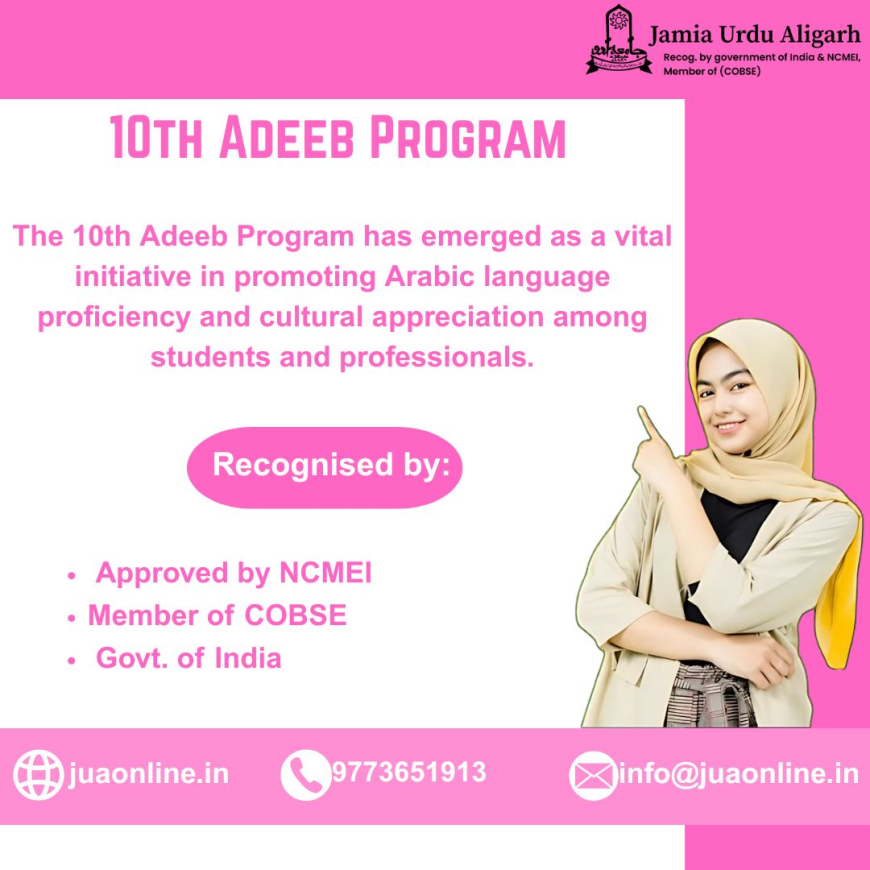The 10th Adeeb Program and the Enduring Legacy of Jamia Urdu Aligarh
The 10th Adeeb Program has emerged as a vital initiative in promoting Arabic language proficiency and cultural appreciation among students and professionals.

In a world where languages are not just modes of communication but bridges between cultures, identities, and histories, the 10th Adeeb Program by Jamia Urdu Aligarh stands out as a remarkable initiative that continues to empower communities and preserve linguistic heritage. As the program marks its tenth edition, it not only celebrates academic continuity but also reflects the deeper mission of Jamia Urdu Aligarh: to provide access to quality education in Urdu, especially for those who may have been left behind by mainstream systems.
Understanding the Adeeb Program
The Adeeb Program is not merely a language course; it's a comprehensive educational platform designed to elevate learners' proficiency in the Urdu language, literature, grammar, and cultural nuances. Adeeb, in Urdu, refers to a learned person or a scholar—someone who not only reads and writes well but also understands the context, philosophy, and aesthetics of the language.Through this program, Jamia Urdu Aligarh offers students an opportunity to attain equivalent literacy to the secondary or higher secondary level. The significance lies in its recognition—students who complete the Adeeb (secondary level) or Adeeb-e-Mahir (senior secondary level) receive certificates considered equivalent to those issued by state boards in India. This is a lifeline for many, especially those who had to discontinue formal education early on or never had access to it.
Jamia Urdu Aligarh: A Beacon of Educational Reform
To understand the Adeeb Program's impact, one must first appreciate the institution behind it. Jamia Urdu Aligarh is more than just a university. Established in 1939, it emerged from the educational aspirations of Sir Syed Ahmad Khan and the broader Aligarh Movement. While Aligarh Muslim University (AMU) pursued higher education in multiple disciplines, Jamia Urdu focused on promoting Urdu literacy at the grassroots level.It is one of the few institutions in India that has consistently worked to protect and promote the Urdu language, which has deep roots in Indian culture, poetry, journalism, and civil society. Unlike many conventional institutions, Jamia Urdu took a decentralized approach—making education accessible in remote and rural regions through correspondence and community-supported learning centers.
Why the 10th Edition Matters
Celebrating the 10th edition of any educational program is a testimony to its relevance and resilience. The 10th Adeeb Program comes at a time when regional languages are facing marginalization due to globalization, digitalization, and urbanization. In this context, the program serves a dual purpose:
-
Preservation of Language: Urdu, with its rich literary history and deep emotional resonance in South Asia, is slowly being overshadowed in formal education spaces. The Adeeb Program revives interest and engagement with the language through structured learning.
-
Educational Empowerment: For many learners, especially from marginalized communities, this program is a second chance at formal education. It provides eligibility for higher studies, government jobs, and professional development.
A Different Language for a New Generation
What sets the 10th Adeeb Program apart is its commitment to evolve with the times. While its core remains rooted in traditional Urdu learning, the curriculum now incorporates elements of contemporary relevance:
-
Digital Learning Tools: With online classes, e-books, and video lectures, Jamia Urdu Aligarh has ensured that students from across India—and even abroad—can access learning materials without geographical constraints.
-
Cultural Relevance: The program doesn’t just teach grammar and vocabulary—it explores poetry by Ghalib, essays by Ismat Chughtai, speeches by Maulana Azad, and the nuances of scriptwriting, storytelling, and modern journalism.
-
Inclusive Framework: People from all walks of life—homemakers, professionals, retired workers, young students—enroll in the Adeeb Program, showing its broad appeal and practical utility.
Personal Stories, Real Impact
The true success of the 10th Adeeb Program lies in the lives it has transformed. Take the story of Shabnam, a homemaker from Bihar, who completed her Adeeb-e-Mahir certification at age 40 and now teaches Urdu in a local madrasa. Or Faheem from Delhi, who used his certification to qualify for a clerical position in a government office. These stories are not rare; they are becoming increasingly common and inspiring.
Looking Ahead: The Future of Urdu and Jamia Urdu
Jamia Urdu Aligarh is not stopping here. Plans are underway to integrate artificial intelligence tools to teach Urdu grammar interactively. Collaborations with NGOs, cultural organizations, and international literary councils are also being explored. The idea is to make Urdu education not just an academic exercise but a cultural movement.Moreover, the institution is focusing on gender empowerment by promoting more female enrollment and offering flexible learning options tailored to women's schedules and challenges.
Conclusion
In a world racing toward rapid technological advancement, there's something profoundly grounding about language—the words of our grandparents, the verses of poets, the proverbs that guide us, and the lullabies that comfort us. The 10th Adeeb Program by Jamia Urdu Aligarh is not merely about learning a language; it’s about reconnecting with identity, history, and possibility.By bringing education into the homes and hearts of people who once thought it was too late, Jamia Urdu Aligarh proves that learning has no age and no boundaries. As we look to the future, the Adeeb Program stands as a proud reminder that a language preserved is a culture saved—and that education in any tongue is a right, not a privilege.

 priya01322024
priya01322024